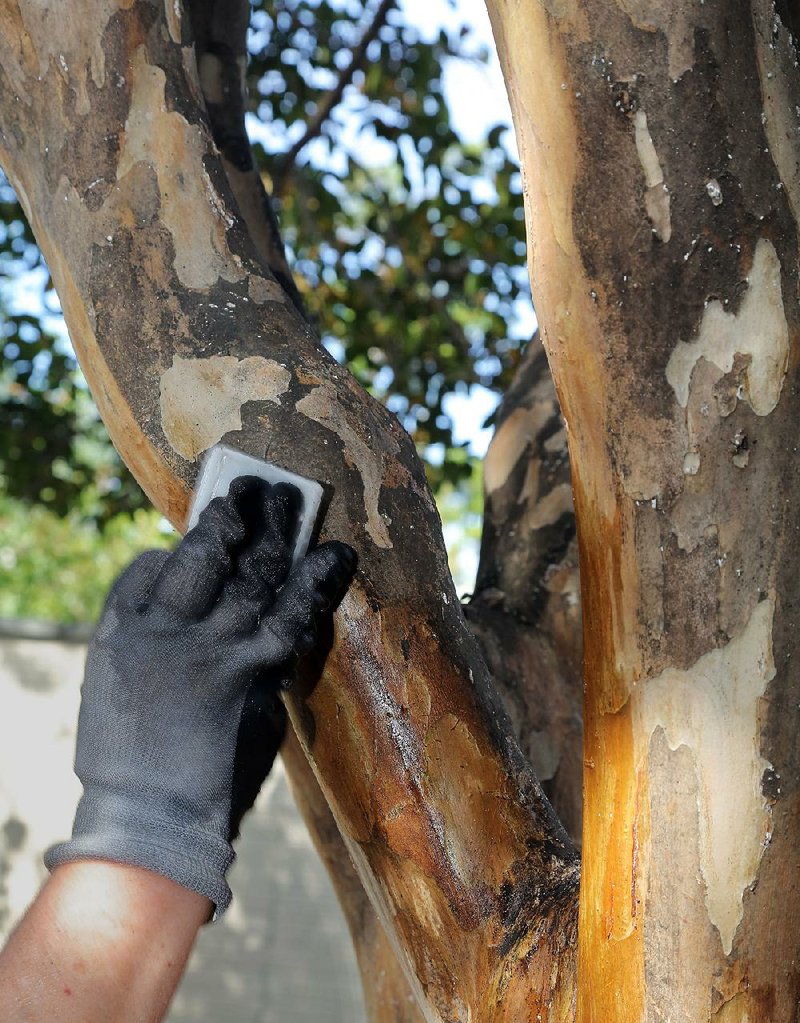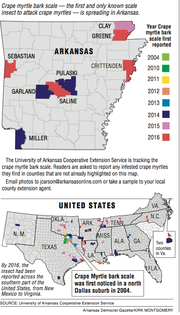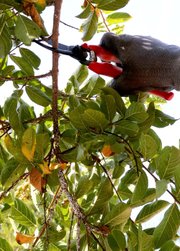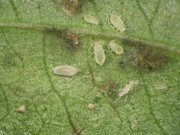The University of Arkansas Cooperative Extension Service last year began urging homeowners to keep an eye out for a new pest. The crape myrtle bark scale was beginning to attack trees in Pulaski County and a few southern counties.
This insect pest was first seen in the United States in 2004, at Dallas, and it moved north and east, spreading quickly across the South. In October 2013, the scale was confirmed in Germantown, Tenn. By January 2014, it was in Little Rock.
Fast-forward to the summer of 2016, and we have confirmed reports in many Arkansas counties, including Garland, Miller, Clay, Saline (Benton), Sebastian (Fort Smith), Crittenden (Marion and West Memphis) and Greene (Paragould).
In central Arkansas, a week has not gone by without new reports of the pest. We are seeing it now on dwarf crape myrtles as well as the standard or tree forms.
Cooperative Extension Service agencies are working together to keep an accurate record of where crape myrtle bark scale is across the South. If you see a tree that shows symptoms of attack in a county that is not highlighted on the map at bit.ly/2eTKzos, please take a picture and send it to jcarson@arkansasonline.com.
Or you could take a sample from the tree to your local county extension office.
NO CHAINSAW REQUIRED
There has been quite a bit of misinformation about this pest, with some gardeners removing the trees when they
spot the problem. There is no need to remove your trees if you find the insect.
The problem can be treated very effectively, and treatment is necessary.
While the bark scale insects will not kill the tree, they definitely reduce the number and size of blooms; and the copious amount of black sooty mold that covers the trunks of infested trees makes them much less attractive.
Long-term effects are not known as this is a new pest. But left untreated, it spreads to other crape myrtles.
CRAWLERS AND ADULTS
Often the first indication of a problem is black blotches on the stems or trunks of the plants. This substance is black sooty mold -- a byproduct of sucking insects including scale and aphids. As these insects feed, they give off a sweet substance called honeydew. Wherever honeydew lands, the stems, leaves and trunk get very sticky, and then the black sooty mold will grow.
If that sooty mold is accompanied by white specks on the trunks or branches, the tree has crape myrtle bark scale, and that is cause for action.
A heavy infestation will result in white crusted clusters of insects, which can blanket small stems and be quite visible on the trunks.
If you get up close or use a magnifying glass, you will see that the adult is white to gray, and there could be dozens of pink eggs or crawling nymphs -- "crawlers" -- under some of the larger white scale covers.
It is believed crape myrtle bark scale can produce at minimum two generations per year in Arkansas.
WHAT TO DO
Systemic insecticides work very well to control the bark scale, but the timing matters. They are most effective when applied in late winter/early spring.
If you spot the problem now:
• Clean the trunk with warm, soapy water to remove the black sooty mold.
• After all the leaves have fallen, saturate the tree with a dormant oil. This should kill many of the crawlers and adults, but won't kill them all.
• In late March through early May, treat with a systemic insecticide containing imidacloprid (Merit or Bayer Advanced Tree and Shrub Insect Control), thiomethoxam (Meridian) and dinotefuran (Greenlight Tree and Shrub Insect Control with Safari).
These products will be taken up by the tree and moved throughout the system of the tree, and have shown good results in controlling the scale.
Be aware that even after the insects die, they will remain on the plant. But they will no longer damage it and spread to other trees.
• There is no need to do preventive treatment. Only treat a tree that has the insects.
• Small limbs that are heavily infested can be pruned. Dispose of them. Do not put them in a compost pile or out on the curb for yard-waste pickup.
Left exposed in an open truck or put on the curb for yard waste pickup, millions of tiny crawlers could be conveyed to neighboring properties, thus accelerating the spread of this invasive insect. Burning the debris would be a sure way to eradicate the pest, but we can't burn refuse in the city.
So double-bag the cuttings and put them in your regular trash pickup.
STUDIES UNDERWAY
Research is ongoing at many Southern universities, where pest experts are studying the insect and its control.
In Arkansas, research found that one application of imidacloprid has provided at least two years of control. Researchers treated one large "Natchez" crape myrtle tree (a trunk was 19 1/4-inches in diameter at breast height, and this plant had several trunks). They applied an imidacloprid formulation at the rate recommended on its label (cost per tree, $2.59).
This systemic insecticide was applied as a soil drench in mid-April 2015, and as of late October researchers are still observing good scale control.
While natural predators appear to help in the control of this scale insect pest, it will require some kind of chemical treatment (e.g., dormant oil or a soil drench of systemic insecticide) to reduce the population to a level that natural predators can effectively manage.
DON'T OVERREACT
There is no need to remove crape myrtles that have the problem. Crape myrtle bark scale is easily managed if you learn to identify it and use recommended control measures.
Crape myrtles will continue to be a recommended plant for the South, and hopefully in time we can eradicate this new crape myrtle bark scale or find resistant varieties of plants.
In the meanwhile, monitor the crape myrtles in your yard and treat if you find the problem. The sooner you can catch the pest, the easier and faster the problem can be solved.
For more information, contact your local county extension office. A fact sheet by extension service experts is online at uaex.edu, search for "fsa-7086."
Janet B. Carson is a horticulture specialist for the University of Arkansas Cooperative Extension Service.
HomeStyle on 11/19/2016




